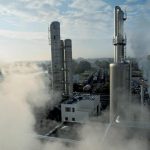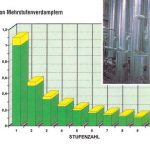Evaporation and distillation processes are traditionally very energy-intensive. Against the background of rising energy costs it makes sense to search for design solutions that cut energy consumption without entailing excessive investment costs. The use of mechanical vapour recompression can lead to a significant reduction in the costs for specific energy in many applications.
In all thermal separation processes involving a transition between the liquid and gaseous phases, the latent heat of vaporisation must first be input and then removed from the process again after separation if a liquid product is needed. The useful temperature difference on the heating surfaces is normally limited by the maximal possible media temperatures as well as by the economically viable condensing temperature level. A central question is therefore how to design the net energy balances so that they make technical and commercial sense. Multi-stage plants or installations based on mechanical vapour recompression (Figure 1) are two examples of energy-saving designs whose potentials are compared in the following. Thermal vapour recompression using steam injectors can be used to advantage in both cases to reduce energy consumption, providing there is a sufficient pressure level above the process for the heating or control steam and the loss of live steam condensate is accepted. This is not considered to constitute a category of its own, however, because the benefits are limited in practice.
Multi-stage plants
Multi-stage plants utilise the heating steam according to the number of stages. There is usually a pressure drop from one stage to the next. The outgoing vapour from the stage that is operated on the higher pres-sure level is used to heat the next stage, operated on a lower pressure level, by condensing the incoming vapour. The vapour from the last stage must be condensed. The condensing power that is transferred to a cooling medium at the end of the process must be roughly equivalent to the heating power at the beginning. Most multi-stage installations work with a condensing pres-sure of 150 to 50 mbar(a). The outgoing energy stream cannot therefore be utilised without further treatment.
The principle of a multi-stage installation is explained taking the example of a clean water distillation plant (Figure 2) for 6000 l/h. The higher the number of stages, the lower the specific energy consumption at both ends of the installation. The maximum number of stages is limited to the available temperature difference between the heating medium and the condensing level, the maximum allowable temperatures at the medium and the economically viable heating surface dimensions. The useful temperature difference of each individual stage is reduced as the number of thermal stages increases. In a single-stage installation, the same gaseous energy is theoretically needed for heating as for evaporation, providing there is no change in chemical composition. If we consider aqueous solutions, where the phase change to gaseous consists of water vapour, 0.25 kg of live steam is theoretically required per kilogramme of evaporated water in a four-stage plant. In practice, the energy demand is higher for all of these processes. All heating surfaces have to be vented continuously in order to keep the concentration of gases that cannot be condensed under the prevailing conditions sufficiently low to enable the condensing temperature to remain at a constant high level.
Mechanical vapour recompression
In contrast to multi-stage installations in simple mechanical vapour recompression plants, the evaporated gaseous phase is condensed on the other side of the heating surface compared to evaporation. A compressor ensures the necessary temperature difference on the heating surface by raising the pressure. This allows the latent heat to be locked inside the process apart from the amounts needed for venting. The plant can be designed in various ways, depending on the specific process requirements. Radial fans can be used for compression. Compared to turbo compressors, the velocities on the impellers are lower, so that the latter can be cleaned without interrupting operation. Even continuous, totally wet operation is possible by spraying condensate on the suction side. To avoid process-related plugging, the amount sprayed is often several times the theoretically necessary quantity for saturation. If there is no real superheating inside the compressor, all surfaces stay wet. Since the eighties, GIG Karasek has used fans for mechanical vapour re-compression in applications with a smaller rise in the boiling point, such as sulphite spent liquor, organic solids in aqueous solutions and milk. Temperature rises of 6.5 K (saturated) can be achieved without any special design measures. This is valid for water under approximately atmospheric conditions. Larger temperature rises are possible using media with a higher molecular mass.
Fans with tip speeds up to 300 m/s or more are used today. Smaller boiling point rises can be handled by a single fan. Special fan models can manage up to 9 K under the conditions described above. If a larger temperature difference is required, two or three fans can operate in series. Some plants have been realised with three series-connected fans and two or three heating pressure lev-els adapted to the respective process conditions as well as to the running and investment costs.
Two principles compared
A comparison of the heating energy requirement of a four-stage installation with that of a plant featuring mechanical vapour recompression confirms the benefits of the latter concept (Figure 3). The concentration stage for a sugar solution with an evaporation rate of 20 t/h was taken for this purpose (Figure 4). In many distillation applications, the principle of mechanical vapour recompression is both practical and economical if a falling film evaporator is used as a reboiler and simultaneously as a head condenser, in which the compressed head vapour is condensed for heating purposes in a single plant. A plant of this kind was built by GIG Karasek in 2003 for 100 t/h isopropyl alcohol head product. The compressor takes the form of a two-stage fan installation. The total energy demand is only 12 % compared to traditional distillation plants.
cpp 421
Information on evaporation and distillation installations
Multiple-effect evaporators
Vapor-compression evaporation
Share:








